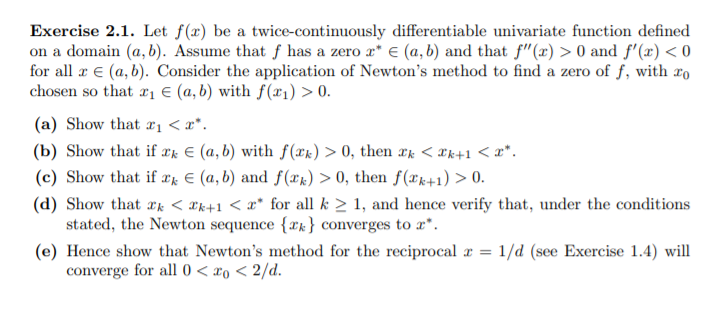Exercise 2.1. Let f(x) be a twice-continuously differentiable univariate function defined on a domain (a, b). Assume that f has a zero a* € (a, b) and that f"(x) > 0 and f'(x) < 0 for all æ € (a, b). Consider the application of Newton's method to find a zero of f, with ro chosen so that r, € (a, b) with f(x1) > 0. (a) Show that xị < x*. (b) Show that if æk € (a, b) with f(®k) > 0, then æk < *k+1 < x*. (c) Show that if ær E (a, b) and f(x4) > 0, then f(xk+1) > 0.
Exercise 2.1. Let f(x) be a twice-continuously differentiable univariate function defined on a domain (a, b). Assume that f has a zero a* € (a, b) and that f"(x) > 0 and f'(x) < 0 for all æ € (a, b). Consider the application of Newton's method to find a zero of f, with ro chosen so that r, € (a, b) with f(x1) > 0. (a) Show that xị < x*. (b) Show that if æk € (a, b) with f(®k) > 0, then æk < *k+1 < x*. (c) Show that if ær E (a, b) and f(x4) > 0, then f(xk+1) > 0.
Advanced Engineering Mathematics
10th Edition
ISBN:9780470458365
Author:Erwin Kreyszig
Publisher:Erwin Kreyszig
Chapter2: Second-order Linear Odes
Section: Chapter Questions
Problem 1RQ
Related questions
Question

Transcribed Image Text:Exercise 2.1. Let f(x) be a twice-continuously differentiable univariate function defined
on a domain (a, b). Assume that f has a zero r* € (a, b) and that f"(x) > 0 and f'(x) < 0
for all æ € (a, b). Consider the application of Newton's method to find a zero of f, with xo
chosen so that r, € (a, b) with f(x1) > 0.
(a) Show that xị < x*.
(b) Show that if ¤k E (a, b) with f(xk) > 0, then xk < *k+1 < x*.
(c) Show that if xk € (a, b) and f(xk) > 0, then f(xk+1) > 0.
(d) Show that æk < æk+1 < x* for all k > 1, and hence verify that, under the conditions
stated, the Newton sequence {xk} converges to x*.
(e) Hence show that Newton's method for the reciprocal r = 1/d (see Exercise 1.4) will
converge for all 0 < xo < 2/d.
Expert Solution
This question has been solved!
Explore an expertly crafted, step-by-step solution for a thorough understanding of key concepts.
This is a popular solution!
Trending now
This is a popular solution!
Step by step
Solved in 4 steps

Knowledge Booster
Learn more about
Need a deep-dive on the concept behind this application? Look no further. Learn more about this topic, advanced-math and related others by exploring similar questions and additional content below.Recommended textbooks for you

Advanced Engineering Mathematics
Advanced Math
ISBN:
9780470458365
Author:
Erwin Kreyszig
Publisher:
Wiley, John & Sons, Incorporated

Numerical Methods for Engineers
Advanced Math
ISBN:
9780073397924
Author:
Steven C. Chapra Dr., Raymond P. Canale
Publisher:
McGraw-Hill Education

Introductory Mathematics for Engineering Applicat…
Advanced Math
ISBN:
9781118141809
Author:
Nathan Klingbeil
Publisher:
WILEY

Advanced Engineering Mathematics
Advanced Math
ISBN:
9780470458365
Author:
Erwin Kreyszig
Publisher:
Wiley, John & Sons, Incorporated

Numerical Methods for Engineers
Advanced Math
ISBN:
9780073397924
Author:
Steven C. Chapra Dr., Raymond P. Canale
Publisher:
McGraw-Hill Education

Introductory Mathematics for Engineering Applicat…
Advanced Math
ISBN:
9781118141809
Author:
Nathan Klingbeil
Publisher:
WILEY

Mathematics For Machine Technology
Advanced Math
ISBN:
9781337798310
Author:
Peterson, John.
Publisher:
Cengage Learning,

